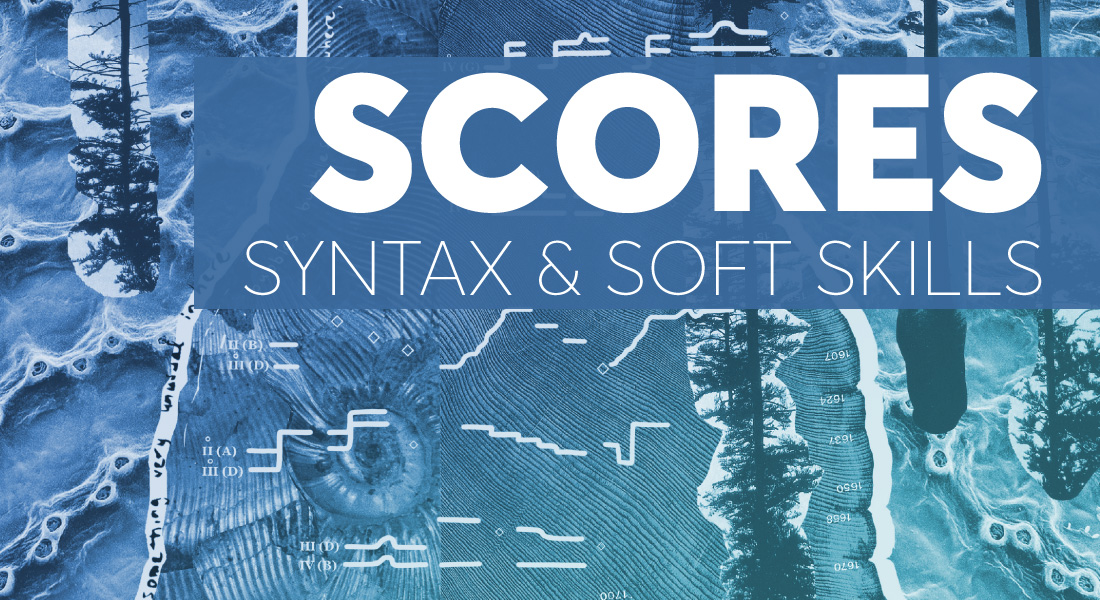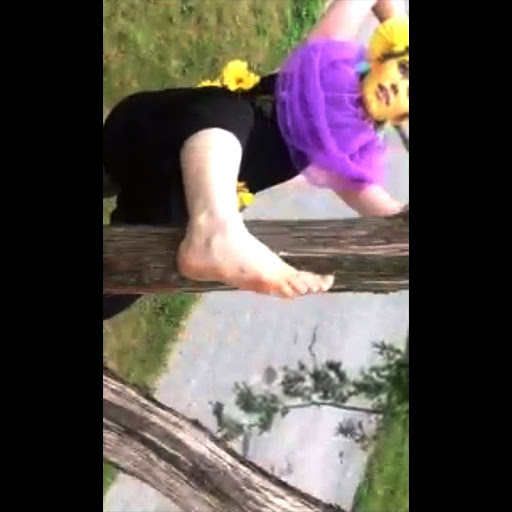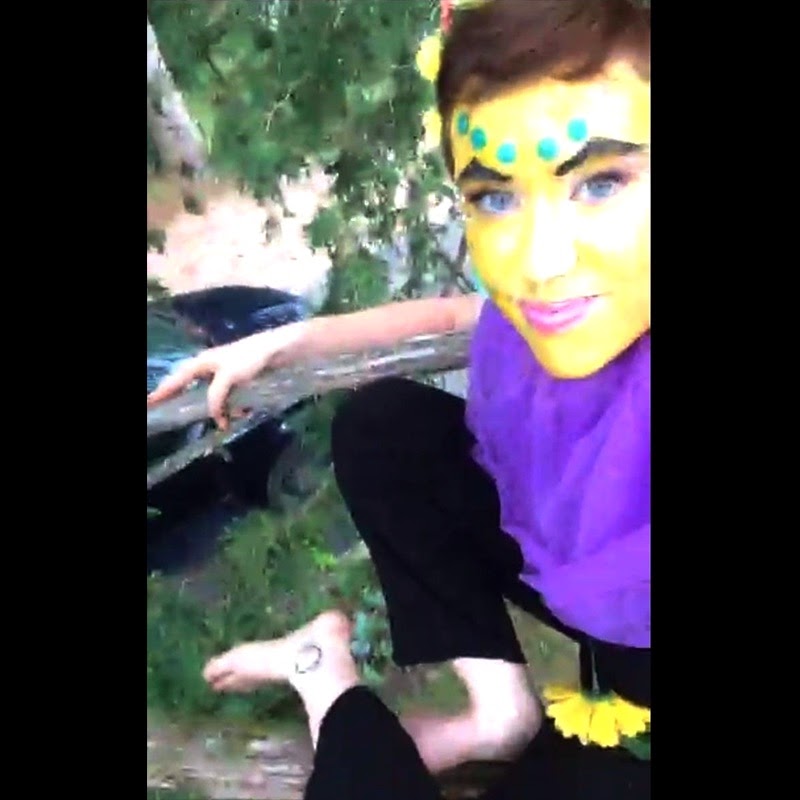Drag • Music • Poetry • Collage • Trees
By Kim Farris-Manning
In 2020, Kim Farris-Manning was selected to participate in the PIVOT program, a mentorship and creative workshop experience for early-career composers. The project was coordinated by the Canadian League of Composers in partnership with Continuum Contemporary Music and the Canadian Music Centre (CMC). Given its history as a repository for scores, CMC Ontario has commissioned reflections from a couple of PIVOT participants whose works played with the form and function of a score. For this piece, Kim/King of Chlorophyll provides an illuminating glimpse into their work.
I like to think of composing as collecting materials and setting the parameters for a piece: gathering its components and organizing them in as clear yet open a way as possible, that will invigorate and not misuse or abuse performers’/collaborators’/audience members’ time or skill. While sometimes I have attempted to capture, discuss or translate musical ideas, I am currently interested in seeing how a score might elicit certain sounds and reactions or spark discussions and exchange with the “reader”. I am grateful especially to my PIVOT mentor Juliet Palmer for helping me to gain the awareness to actively pursue different modes of score-making that align more fully with the process-based, collaborative-to-the-core approach I strive to take in my creative work.
King of Chlorophyll
a drag arborist graphic audio chapbook
by Kim Farris-Manning
Note to the performers:
Refer to the text and visuals of the chapbook as you learn and perform this piece. Kind of like a walk in the forest, the performers should focus on immersing themselves in this audio-visual world and absorbing its intrinsic realities. The piece is less about performing specific sounds/actions and more about discovering the possible connections and textures of the space. The most important thing above all else is to trust your fellow performers, your gut, and to support the ecosystem around you.
Think not just of yourself / the here / the now – rather think of what / who will come: how will your actions open or close opportunities for yourself and others later? What do you need? What can you give?
LIES / TRUTH
I’ve often toyed with the dialectic of ‘the role of the composer’, and how to not let it, or me, get in the way. The catch (I think) is putting your finger on that magical balance between connecting the dots/structuring material and relationships enough to be clear and offer support, while avoiding writing what you don’t know, what should be left open, or what should be decided by someone else.
Meeting expectations, showing up and doing good work are one (or three) thing(s), but since classical chamber music is created “live” in time by real humans, I think it’s pretty important to find ways to listen to the performers (or potential performers – that gets trickier and slightly more meta) and engage with them, however possible, throughout the creation process.
Perhaps the most obvious example of this is in the animated score for MAP; gest, my piece for acoustic pipe organ and live electronics that unfolds inside a 3D VR dome inspired by the distorted charted reality of conical projections and globes. The program note reads:
“The fundamental problem of maps is that the earth is a sphere and that paper is flat.” (David Stratkauskas) A similar quandary exists with musical scores, as with anything that lies on the border of imagination and representation, the danger being that if you write down a lie, it might look like the truth. [program notes]
I don’t want to lie to you –
and I’ve spent some time checking this place (read: piece) out,
so would like to help you navigate:
show you the good spots,
-what the locals notice.
| But if I build it up too much, | |
| you might be disappointed | |
| If I show you a shortcut, | |
| you’ll miss something along the way | |
| If I give you a rotten landmark, | |
| you may stop trusting me | |
| And if I say too much | |
| you may lose the joy of discovery |
[alternate] Note to the performers:
Thank you for trusting me
I’ll try my best to follow
ACTIVE ARTEFACT
With King of Chlorophyll, I wanted the score to be an artefact as close to the act and process of creation as possible: to let it build and breathe in similar ways.
I love the idea and feeling of collective experience, and often strive to find ways to engage the audience and performer(s) throughout each of the many stages and aspects of a work, rather than simply presenting a siloed final product.
This piece deals largely with interconnectivity and relationality: I wanted to make sure that the connections and synergies I was seeing were communicated with the musicians, so I tied visual elements from the book/video into the musical score. This helped me to express my thinking, similar to how we are taught to do in math: sometimes it is more valuable to “show your work”, demonstrate the connections you are making, and retain the potential for any number of as-yet undefined outcomes. I’ve outlined a few examples below:
*This is something I am so grateful to have learned early on, from my composition teacher in undergrad Christopher Butterfield, who encouraged my habit of drawing and writing everything down, keeping a record of thoughts, and tracking my art gut.
- The green webbing from the “Spring” look found its way into the violin and cello in movement 2, as a “weaving game”. I also scanned some of the same costume material overtop of some collage cutouts to create the graphic score.
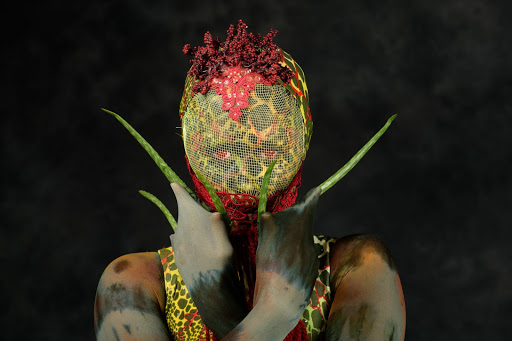
Spring

King of Chlorophyll, Movement 2, violin + cello (excerpt)
2. I don’t actually remember which came first – score or beard – but movement 6 and the “winter” look were both heavily inspired by mushrooms and slow, cold, creeping growth/decay. You’ll sometimes hear some knocking sounds in the recording here and in other movements (end of the bow against the cello, and a small wooden top against the keys) which are literal translations of bark/wood to sound.
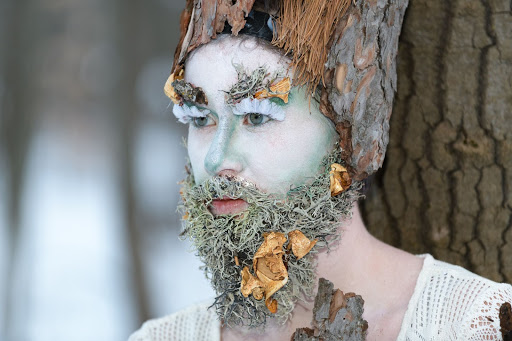
Winter
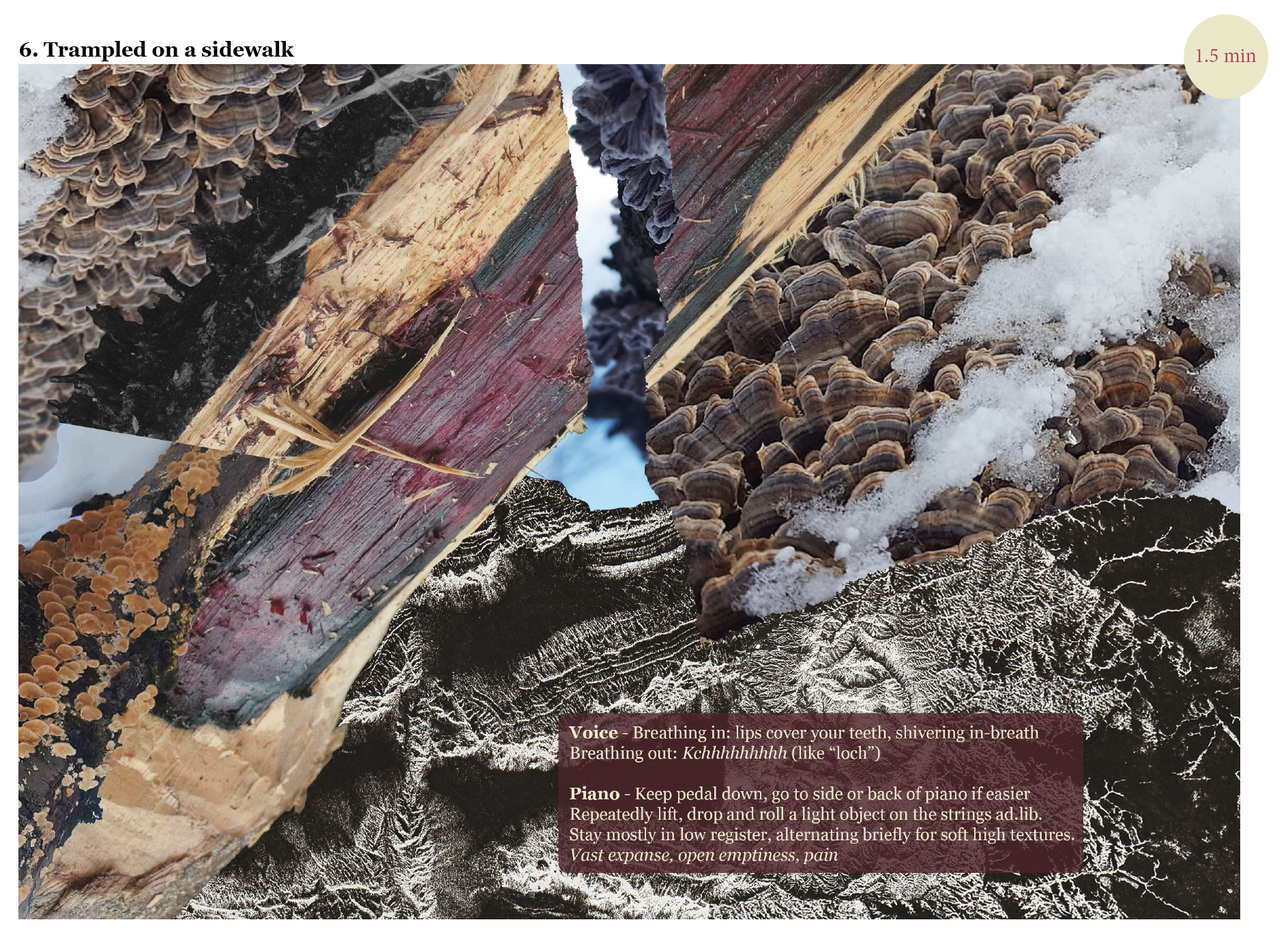
King of Chlorophyll, Movement 6, piano
3. I made “aerial roots” suspended from the arms in the “summer” outfit and posed in multi-exposure photos to capture motion: particularly feelings of rotation and breath. In movement 5 the pianist pulls magnetic tape inside the piano in large motions, similar to the bowing arms of the string players who are also encouraged to lead with their breath.
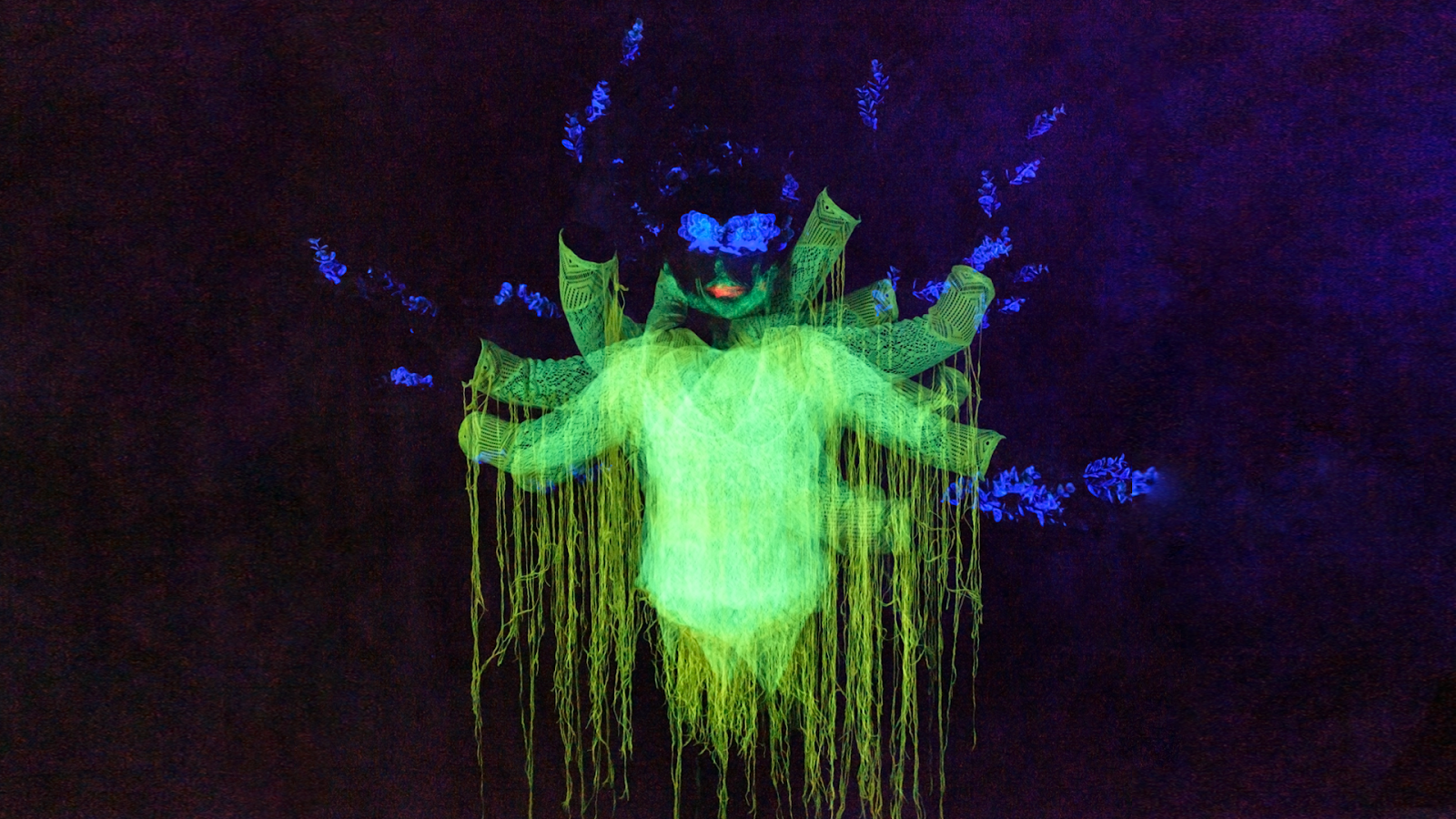
Summer
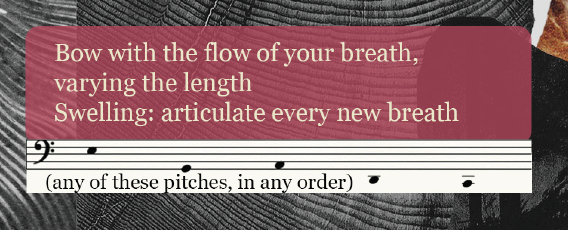
King of Chlorophyll, Movement 5, cello (excerpt)
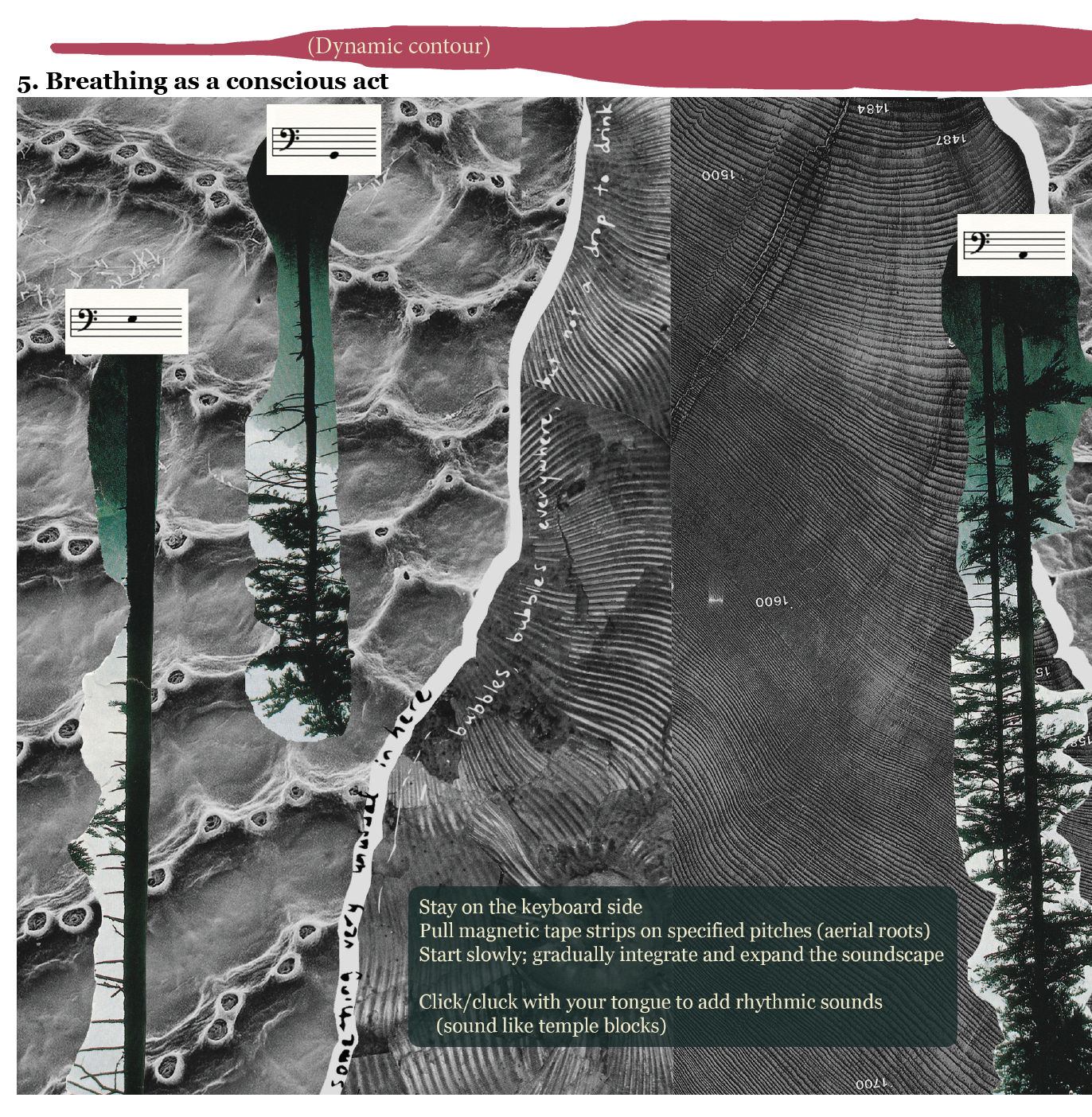
King of Chlorophyll, Movement 5, piano (excerpt)
DRAGGGGGGG
*If you’re confused by this point about whether this is a book or a piece or a video or who knows what exactly, you are probably not alone. It is currently a video with music, written text, photos, collage and animation; however I’m working on making a hardcopy book with accompanying audiotape.
This project began as a creative way to explore my queerer sides when I abruptly moved from a rainbow apartment on St. Catherine Street in Montreal to be with family in an Ottawa suburb during the pandemic. The move coincided with my haphazard entry into arboriculture and the art of climbing trees – and the rest grew from there. [program notes]
Stumped by my own gloomy life updates and the much larger, very scary events taking place around the world, I had fallen into a bit of a pandemic stupor and wanted an outlet for extravagant joy, or radical extravagance.
Massively homesick for my queer community and previous day-to-day, I found myself feeling slightly unhinged and not quite myself, not knowing who “myself” was.
“…[Man] is least himself when he talks in his own person. Give him a mask, and he will tell you the truth.” -Oscar Wilde
In the age of protective facewear, I decided the way forward was to don yet another mask. I started researching drag, googling things like “can girls do drag”, “what are drag kings”, “bio-queens”, “gender-fucked”, “non-binary drag”, “drag thing”, “shape-shifting”, “drag creature”, “DIY drag”… Soon after, with my friend running an expert photoshoot (screen captures via Facebook video chat, #pandemiclife) King of Chlorophyll began to sprout where I felt the safest and the most free: in a tree.
I began experimenting with makeup, costumes, and wearable sculptures: learning all the fun, magical ways I could play and find wonder and tantalize the senses. Currently training as an arborist, one day I watched one of my coworkers walk away with a pile of brush from a fiery maple we had just pruned, and I was struck by the way it fell and moved and told a story like high fashion. I quickly diverted the branches from the chipper to my car, took them home and began constructing what would become the “fall” look for this drag arborist graphic audio chapbook.
With the support of the CNMN ConneXions mentorship program, I had 3 targeted sessions with my drag mom Bijuriya to work on the remaining looks for this project. Bijuriya took stock of my makeup kit and helped me fill it out with some essentials, and proceeded to blow my mind with skills and techniques I knew little-to-nothing about. She showed me instagram accounts to follow, pointing out drag artists with similar face shapes and artistic styles. Sometimes I showed her parts of the score or book-in-process, and we’d explore different ways to approach an outfit or mug (face) to express what I was thinking about. But the thing that stuck out the most to me, and that I have been obsessed with ever since, was actually something she said in an Instagram Live video called “Finding your drag identity”, hosted by @itgetsbetterindia. Through further discussion and reflection this idea grew to become the bedrock of this drag “recipe” that I have used to cook and repeat ever since:
Find the parts of yourself that you love already.
Highlight them, put them to the fore.
Then support those bits that you haven’t dared to touch yet, and embellish them; make them elaborate, exaggerated, possibly uncomfortably grandiose – reckon with them.
Let these foils be in relationship with each other:
hold dialogue between them, and watch them stray apart or fuse.
Be as marvellous as you need to be
to show other people
all the intricacies
of this beautiful corner of your/that being.
*
Excuse me for a minute (5 hours)
[trot trot trot]
I’m gonna go get all done up
so you can see me bare
TITLES AND TEXT
I originally had the “chapbook” portion of the project – the poem – typed as a sort of header at the beginning of each movement of King of Chlorophyll, to help set the tone and context for the musicians. That felt stilted, a bit obnoxious, and over the top. While the chapbook and the score are deeply interrelated, I didn’t want the musicians to have to refer back and forth between both works. I settled for titles to be concise, and found they were not just a tool but that in fact they added merit to the artistic work, so in the end they made their way as a structural element into the video as well. Go figure.
- The Forest at Night
- The Administrators
- It’s a Free World, after all
- The Pain of History
- Breathing as a Conscious Act
- Trampled on a Sidewalk
- Private Runway
- Untaming Neverland
- The Living Truth
*
What happened with the text? (“I don’t hear it in the piece!”)
It stayed written down.
Sometimes I think poetry speaks louder by itself.
TRUST
Any artistic act demands a certain amount of risk; when new methods and approaches are introduced, it becomes even more important to have a strong, interconnected foundation of trust in the composer-performer-audience matrix. In King of Chlorophyll, I decided to mitigate the performers’ bounty of risk by offering support (signposts) and care (comfort rest stops).
Signposts
I began the piece with physical, dramaturgical instructions and introduced graphic improv “mini-tasters” in movements 2 and 3, sandwiched between a simple opening movement and baroque-inspired movement 4. (See “Comfort rest stops” below) I used standard notation and more choreographic, how-to-move-your-body instructions in these initial movements to try to set the tone and introduce the visual language before diving into full-on open graphic score interpretation later on.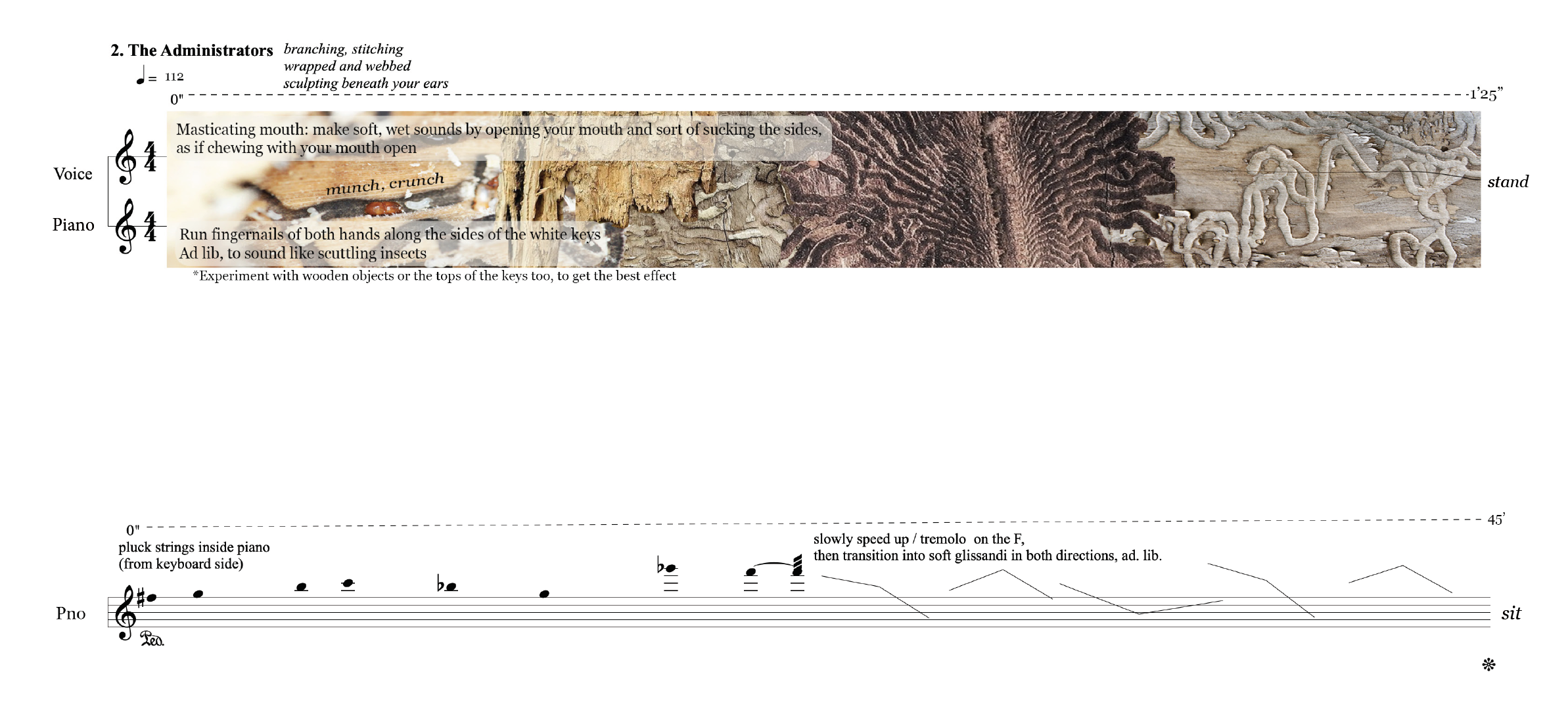
King of Chlorophyll, Movement 2, piano
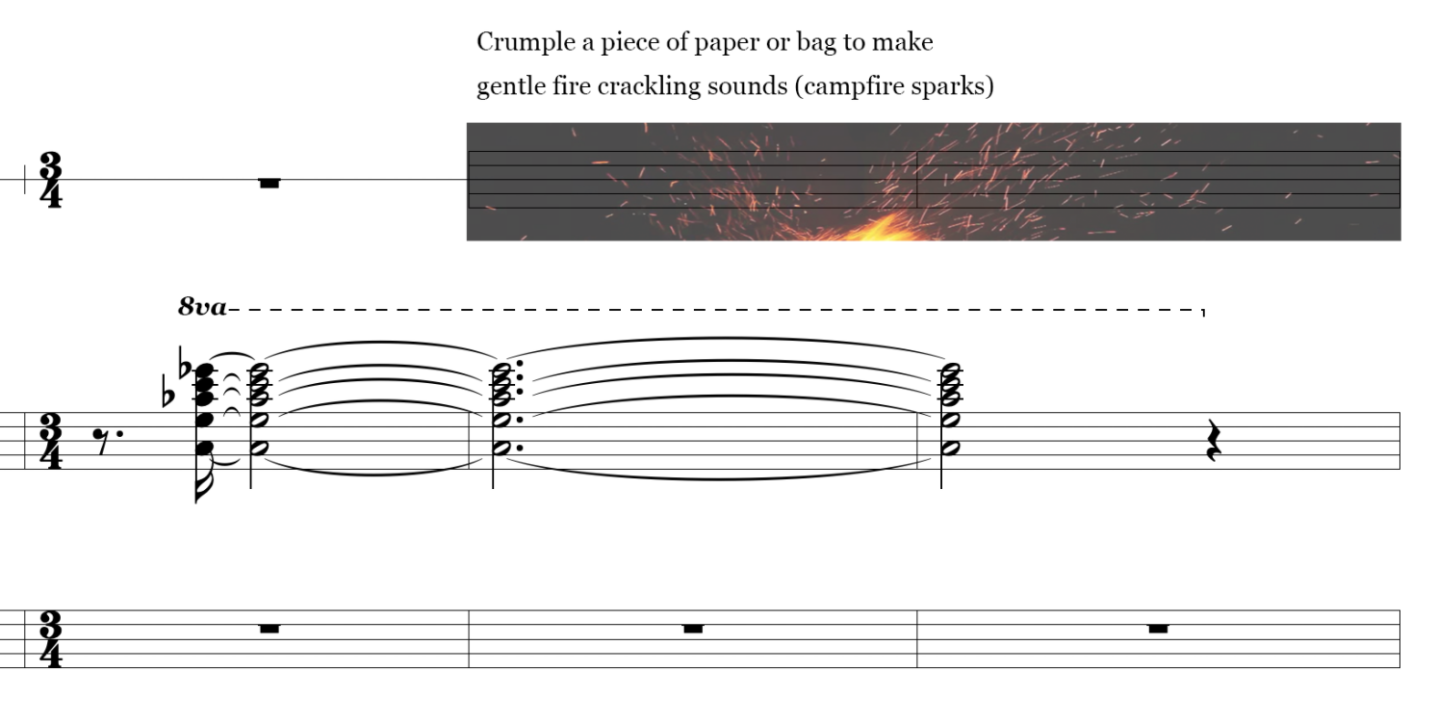
Movement 3 piano excerpt
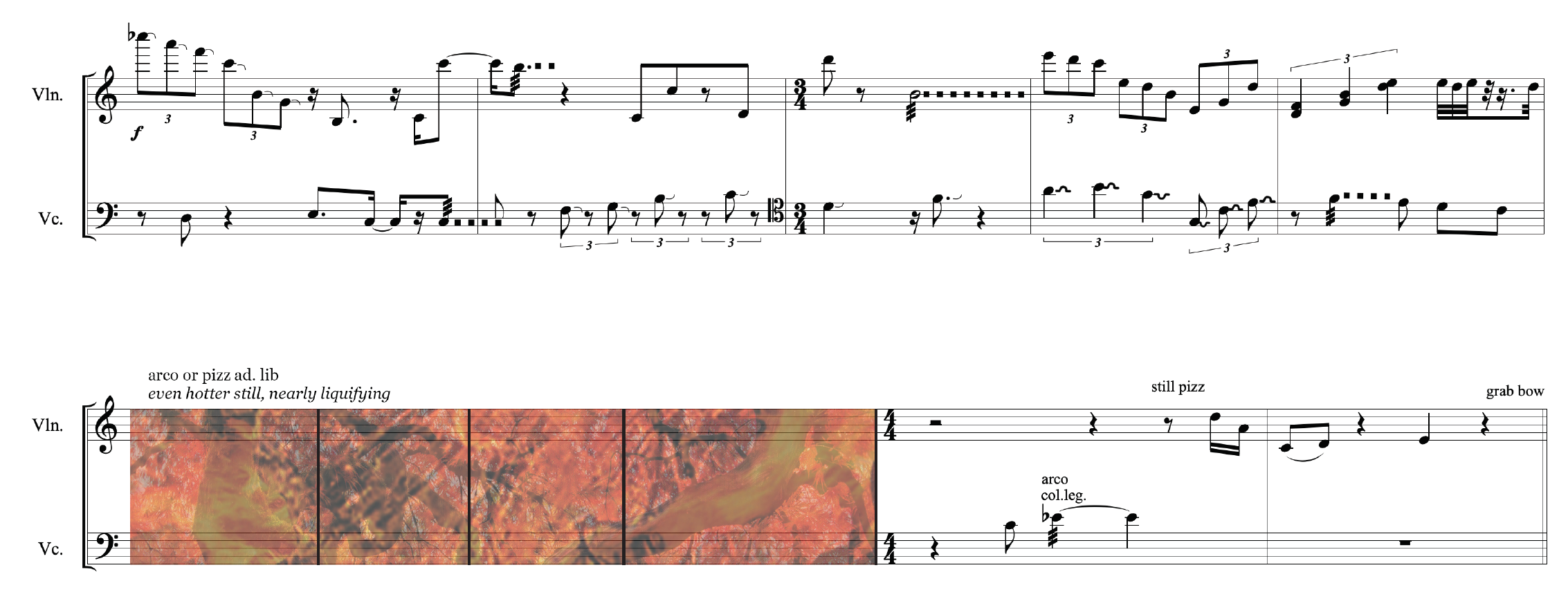
King of Chlorophyll, Movement 3, strings (excerpt)
Movement 5 is the first fully graphic movement, in which each performer sees the same image but their “part” is set in colour against the black and white textures of the other two performers. This helps establish a certain hierarchy of sounds and simplicity of instructions while maintaining an awareness of the whole.
*This is actually the first collage I made for King of Chlorophyll, and definitely the one to blame for how the score ended up working out. Thinking back, I am SO grateful to my mentor Juliet Palmer who, when I showed her this movement, saw how collaging made me light up and reflected this back to me (I was originally thinking of it as just a sketch, and that I’d have to “write it out” after). With her encouragement I did it again, and again, and went back and added things in elsewhere, and slowly the piece started to make more sense.
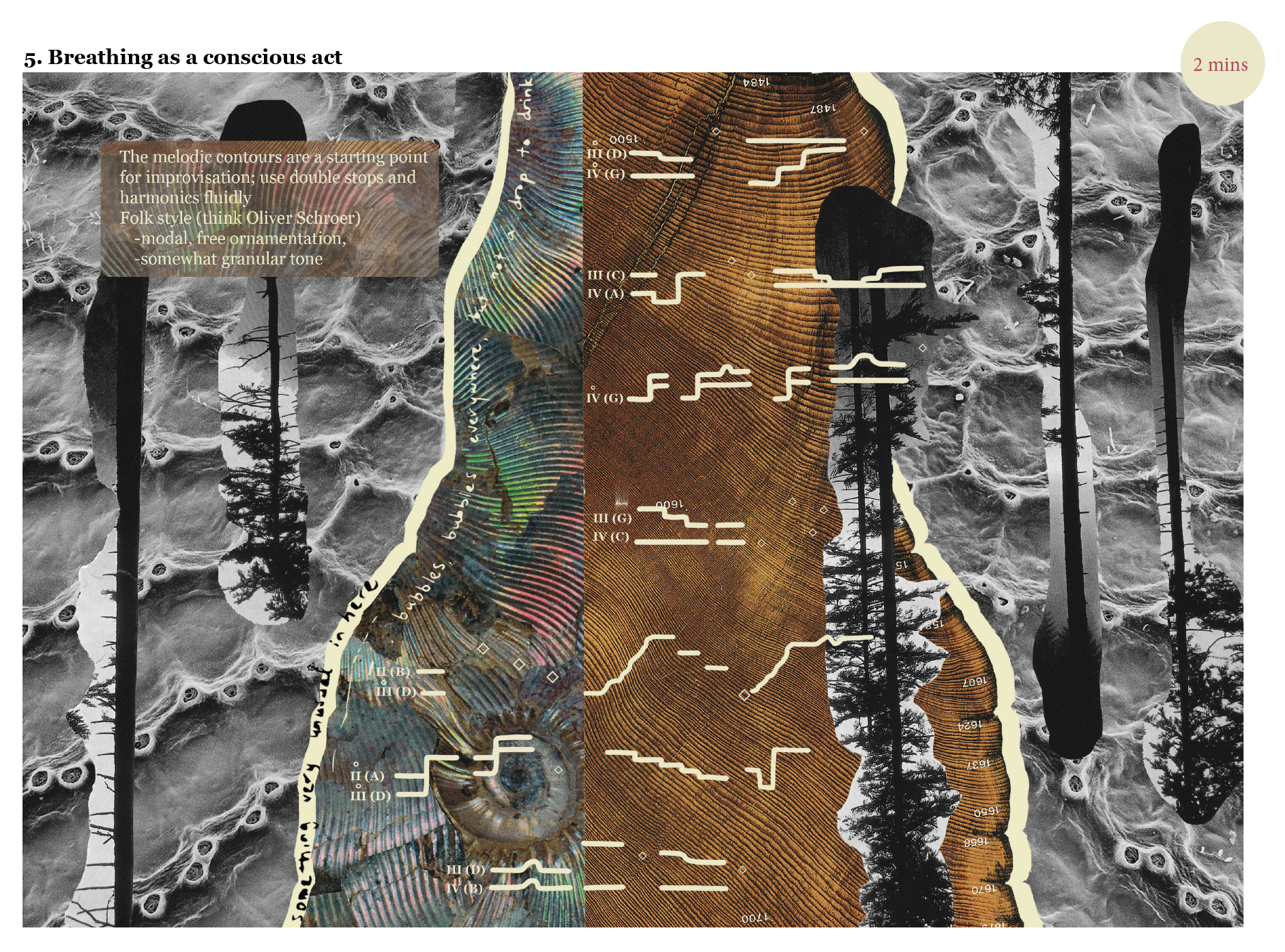
King of Chlorophyll, Movement 5, violin
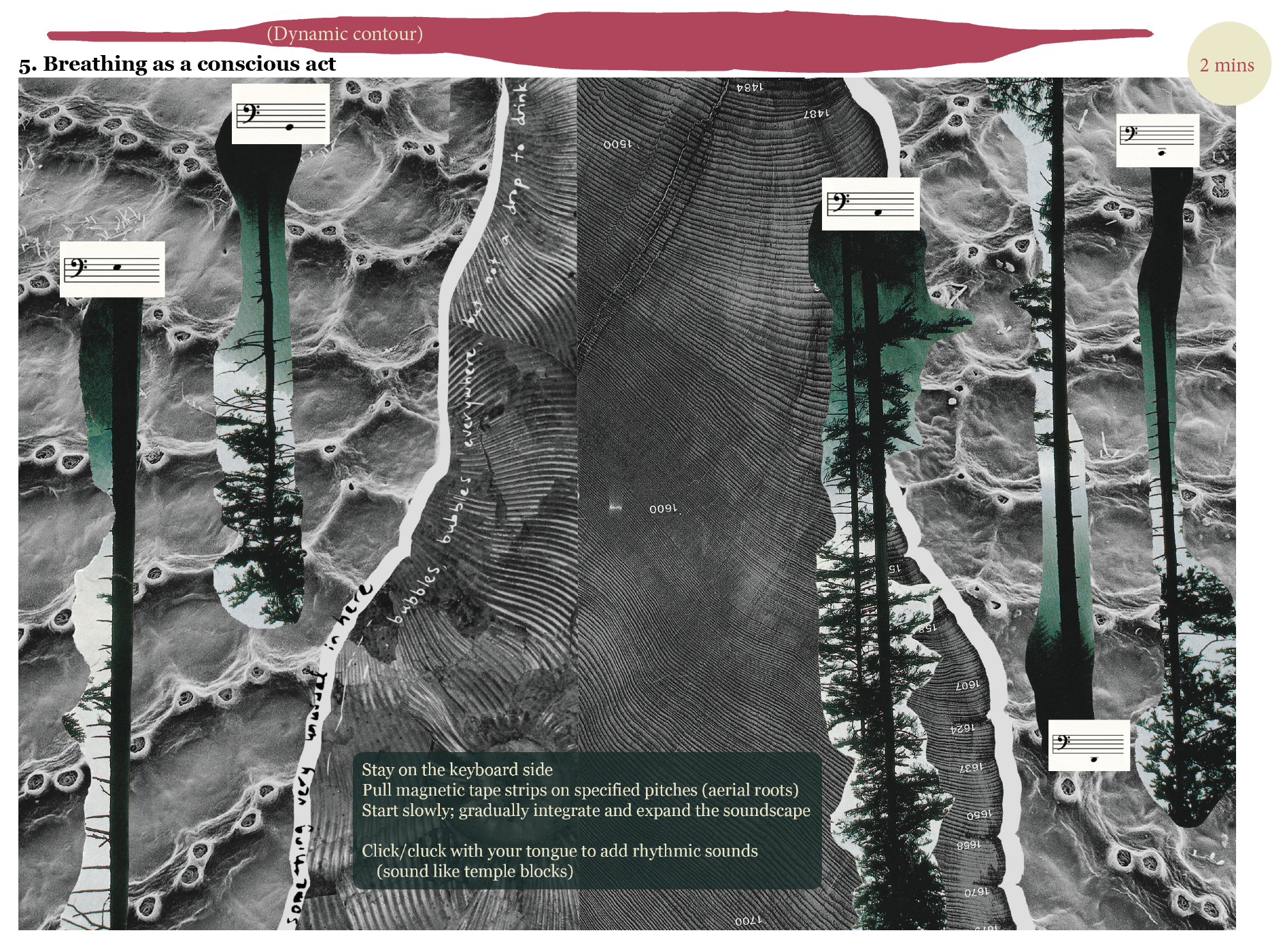
King of Chlorophyll, Movement 5, piano

King of Chlorophyll, Movement 5, cello
Once this visually inspired improvisational language has been established, movement 6 invites all 3 performers to interpret an entire image together, with different texts cueing them to listen for certain things from each other and therefore situate themselves within the texture of the overall sound and image.
*When Greg, Paul and Carol of Continuum played through this movement in rehearsal, none of us were sold; but they spent a few minutes telling me how they would read the collage and offering sounds and techniques that came to mind, so we ditched the initial text instructions I had written and revised the movement. Workshopping is amazing for this, but it’s a fine line between abusing people’s time and being open to having them contribute meaningfully to the piece. Luckily these folks, and the PIVOT program, are rad.

King of Chlorophyll, Movement 6, violin
There are certain techniques and sounds that are recycled throughout the piece, which helps focus and restrict the sounds in the bank of options available to the performers. Movement 7 features a “musical runway” that serves as a foundation overtop of which the performers can recycle freely and “try on” each other’s parts or bring back some of their favourite moments thus far. It is kept short at one minute because it is meant to be playful, indulgent and to feel good.
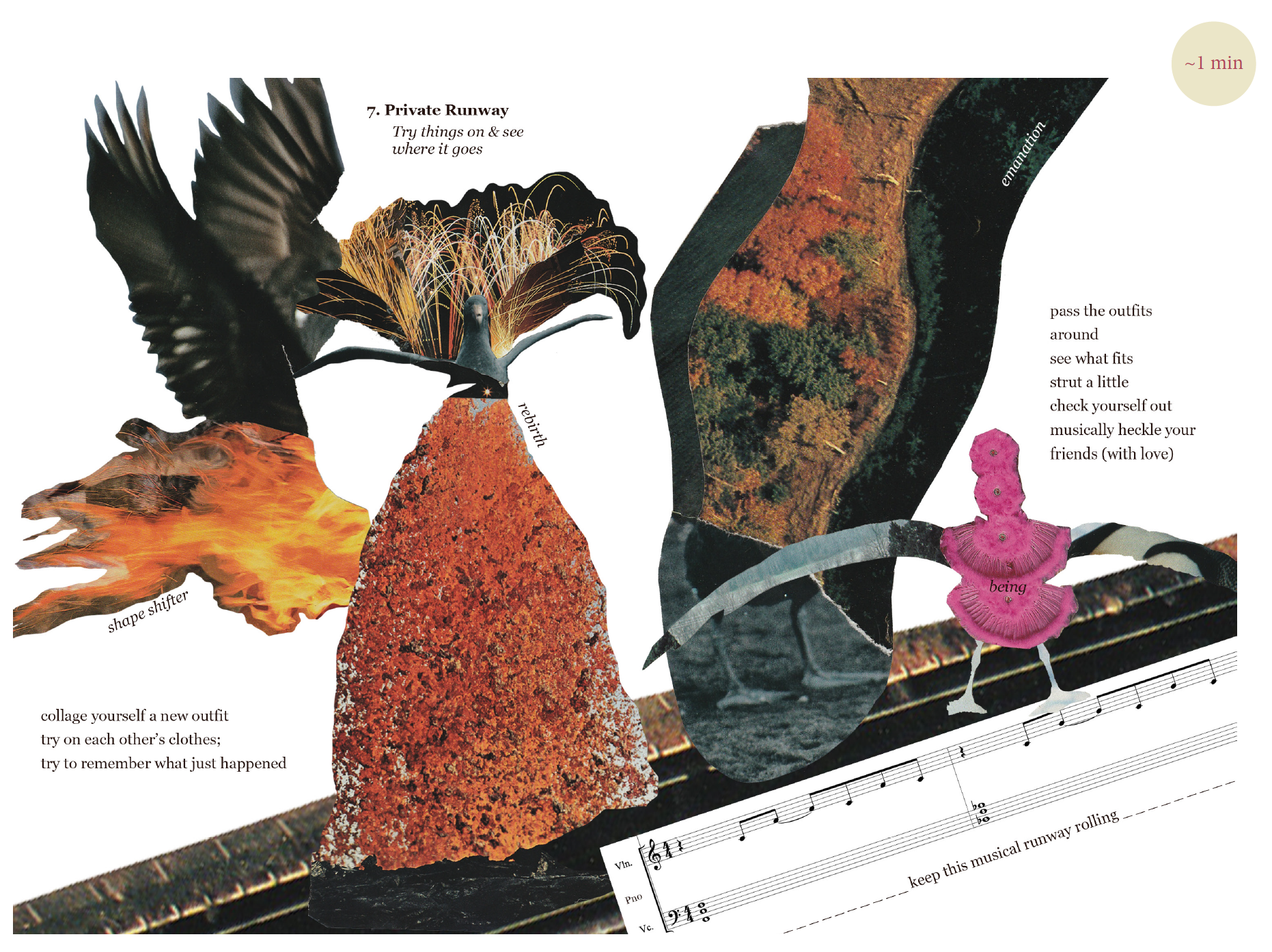
King of Chlorophyll, Movement 7
Comfort rest stops
Creativity is demanding and can be highly vulnerable; I’m not sure it is something that can or should be sustained continuously, and it is important to take time to Rest, Recover, Rejuvenate! Movements 4 and 8 feature notation styles and techniques that are most likely familiar and comfortable to Western-classically trained musicians (with a twist!). Movement 9 is a bit of a graft of the opening and invites the musicians to come together to listen and gather a chord and melody amongst themselves.

King of Chlorophyll, Movement 8, excerpt
RECIPROCITY
As I begin to study the lives of trees and the teachings of forest stewards (Robin Wall Kimmerer, Diana Beresford-Kroeger, Suzanne Simard…), I am struck by the creative ways that they find to communicate with people in non-standard ways. It also strikes me that if a score is a means to communicate actionable ideas and abstract concepts, there must be a lot to learn about how to do this from beings living and working outside the musical field.
Near the beginning of the creative process involving King of Chlorophyll, Juliet pointed me to this keynote presentation by Robin Wall Kimmerer, “What does the Earth ask of us?” Kimmerer spoke of reciprocity, explaining that “it is not the land which is broken, but our relationship to land,” and asking, when we feel gratitude towards our kin, other earth beings, “what will we give in return?” I’ve been thinking about the constantly cycling states and processes encapsulated in this word, reciprocity: of gratitude (receiving gracefully) and giving (returning generously).
When thinking about Kimmerer’s teaching in terms of music and art, I am led to wonder how artistic practices and our relationship to art might be broken. The relations are manifold between composer/performer/audience and score/performance/engagement.
When, and for what, can we hold gratitude?
How, and what can we give?
About Kim Farris-Manning | A fun-loving queer arbor-artist based in Ottawa and Montreal, Kim Farris-Manning creates works across disciplines that engage with the performer and audience in unique ways.

